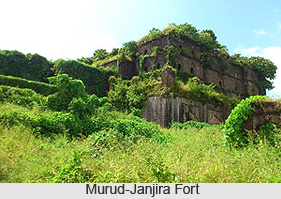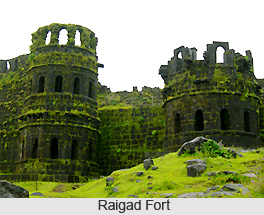 Forts in Raigad district, Maharashtra, are the ancient monuments built by different rulers to protect the royal families and their subjects. Surrounded by huge walls, these forts exhibit impressive architecture in terms of defence as well as artistry. Although much part of the forts has been ruined over time, they still display their former grandeur among the relics. Forts in Raigad district unfold various events of Indian history and form alluring tourist spots. These massive forts have been the witness of numerous battles and have changed many possessions. Several constructional features have also been added to them with time.
Forts in Raigad district, Maharashtra, are the ancient monuments built by different rulers to protect the royal families and their subjects. Surrounded by huge walls, these forts exhibit impressive architecture in terms of defence as well as artistry. Although much part of the forts has been ruined over time, they still display their former grandeur among the relics. Forts in Raigad district unfold various events of Indian history and form alluring tourist spots. These massive forts have been the witness of numerous battles and have changed many possessions. Several constructional features have also been added to them with time.
Avchitgad Fort
Avchitgad fort is a hill fort located over the Sahyadri ranges near Roha in Raigad district. Medha is a village situated at the base of the fort. It is believed to have constructed by Shilahar kings. Reconstruction work had been done in the fort by the great Maratha king Chhatrapati Shivaji. Dense forests surround this fort.
Karnala Fort
Karnala fort, also famed as Funnel Hill, is located in Raigad district near Panvel city. It stands within Karnala Bird Sanctuary and is a protected monument. The possession of the fort changed many hands. It is in fact a combination of two forts standing at different elevations. It houses two inscriptions in Persian and Marathi.
 Kolaba Fort
Kolaba Fort
Kolaba fort is an ancient military fortification situated near the shores of Alibaug. It has been declared as a protected monument and serves as a popular tourist destination. A unique feature of the fort is the freshwater wells in the fort premise in spite of its location near the sea. It also shelters a Siddhivinayak temple which was built in 1759 by Raghoji Angre.
Korlai Fort
Korlai fort, located in Korlai town, is a Portuguese fortification. It stands on an island guarding the way to Revdanda Creek. It was constructed in 1521 and was later demolished by the Portuguese themselves. Reconstruction work was later carried out in the fort. The fort was captured by many rulers over years.
Murud-Janjira
Murud-Janjira is another old fort of Raigad district situated on an island near the coastal village Murud. Siddis had occupied the fort in ancient times and it is famous as the only fort in the western coast of India which could not be conquered by the Marathas, Dutch and East India Company. This 15th century fort stands on an oval shaped rock over Arabian Sea and is regarded as one of the strongest marine forts of the country.
Padmadurg Fort
Padmadurg fort, also referred as Kasa fort, was constructed by the great Maratha ruler King Shivaji. Owing to the effects of Tsunami in Indonesia, the fort has almost completely ruined. The fort has six bastions. The main walls of the fort have demolished and cannot prevent the sea water from entering, as a result of which some portions of Padmadurg are often taken by the sea waves.
 Raigad Fort
Raigad Fort
Raigad fort, located near Mahad in Raigad district, is a hill fort and served as the capital of Maratha Empire in 1674. It stands on Sahyadri mountain range and rises to a height of 820 metres. It was later looted and demolished by the British troops. It was constructed in 1030 by Chandrarao Mores and is presently in ruins.
Sudhagad Fort
Sudhagad fort, a hill fort located in the south of Lonavla, is also popular as Bhorapgad. It dates back to 2nd century BC. Being one of the well preserved forts of Maharashtra, it forms a popular trekking destination. The fort offers a panoramic view of other forts located nearby. Trees of Pandhri can be spotted on the slopes of the fort which is used to make walking sticks.
Revdanda Fort
Located at the mouth of the Kundalika River, Revdanda Fort dates back to 1524, the year it was completed. The fort was built by Portuguese Capt. Soj and was in the control of Portuguese until it was captured by Marathas in 1806. Finally it was captured by British in 1818. The main entrance is from the southern side.
Sagargad Fort
Sagargad Fort is located in the Alibag taluka of Raigad District, Maharashtra. While there is no solid fact to trace the date of construction of Sagargad fort, it was conquered by Shivaji Maharaj from Adil Shah in 1660 A.D. It was one of the 23 forts handed over to Mughals in the Treaty of Purandar and also among the 16 fortified posts that were given to Kanhoji Angre by Balaji Vishwanath Peshwa in 1713. It is a 2 hours trek from Khandale village and is a popular tourist destination throughout the year.
Manikgad Fort
Manikgad fort is a mountain fortress and temple located in Gherakilla Manikgad, Maharashtra. Built by Sarkhel Kanhoji Angre and ceded in 1718 by Peshavas, this fort and temple is a famous trekking spot. Manikgad fort was constructed to oversee the trade route from Pune to coastal ports. Currently, the fort is in ruins.
Kothaligad Fort
Kothaligad is a small fort located to the east of Karjat, Maharashtra. Also known as the Fort of Peth, it is a popular trek route in the Karjat area. Dating back the 13 century, the fort was captured by Abdul Kadir in 1684 on the commands of Mughal Emperor Aurangzeb. In 1716 it was conquered by the British and remained a part of British Empire until it was captured by the Marathas in 1817 under the leadership of Bapurao who was general of Bajirao Peshwa.
Other forts in Raigad district
Here is a list of some of the lesser-known forts in Raigad district
Birwadi Fort
Dronagiri Fort
Konkan Diva Fort
Kurdugad Fort
Lingana Fort
Prabalgad Fort
Sarasgad Fort
Sarjekot Fort
Ghosale gad
Kalavantin Durg
Mrugagad Fort
Padargad Fort
Tungi Fort
Underi Fort
Vikatgad Fort
Talagad Fort
Khanderi Fort
Surgad Fort
Mangad Fort
Mangalgad Fort



















